Unit2IsitanAfricanelephant外研版七上课件
- 格式:ppt
- 大小:3.90 MB
- 文档页数:19
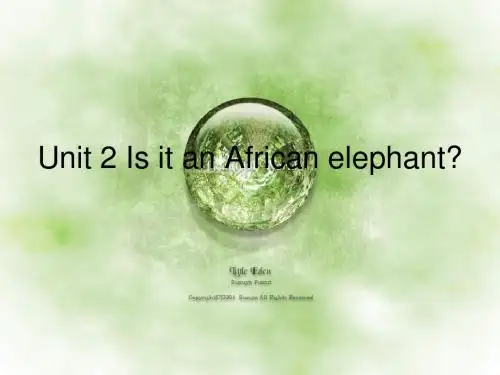

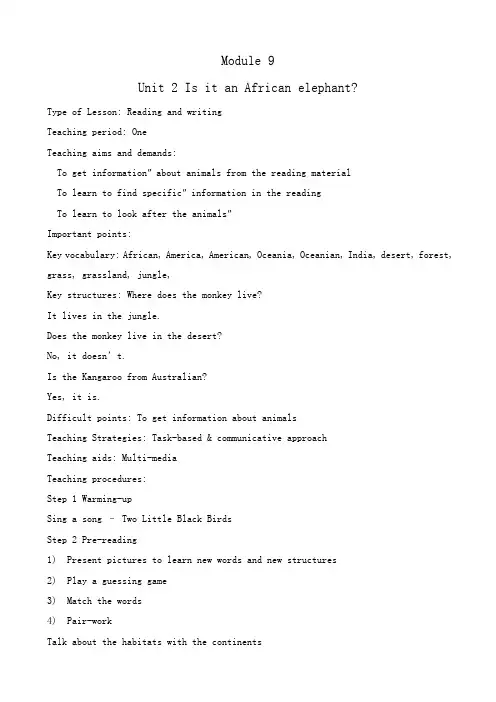
Module 9Unit 2 Is it an African elephant?Type of Lesson: Reading and writingTeaching period: OneTeaching aims and demands:To get information" about animals from the reading materialTo learn to find specific" information in the readingTo learn to look after the animals"Important points:Key vocabulary: African, America, American, Oceania, Oceanian, India, desert, forest, grass, grassland, jungle,Key structures: Where does the monkey live?It lives in the jungle.Does the monkey live in the desert?No, it doesn’t.Is the Kangaroo from Australian?Yes, it is.Difficult points: To get information about animalsTeaching Strategies: Task-based & communicative approachTeaching aids: Multi-mediaTeaching procedures:Step 1 Warming-upSing a song – Two Little Black BirdsStep 2 Pre-reading1) Present pictures to learn new words and new structures2) Play a guessing game3) Match the words4) Pair-workTalk about the habitats with the continentsStep3 While-reading pair-work1) Find answers for the questions about the passage2) Group-workRead it again and fill in the table, do a report3) Find out the language pointsStep4 Post-reading Task 1 pair-workRead the table and write about the animal students like.Step5 Post-reading Task 2 Group-workMake a survey about students’ favourite animals and how to keep them.Step6 Sum-upKey Words: Africa—African America—American Oceania—Oceanian Asia—Asian Australia—Australian India—Indiandesert, forest, grass, jungle, grasslandKey Grammar: 一般现在时里,一些动词的第三人称变化:do—does live—lives come—comeseat—eats have—hasget—gets speak—speaksStep7 AssignmentWrite something about your favourite animals。
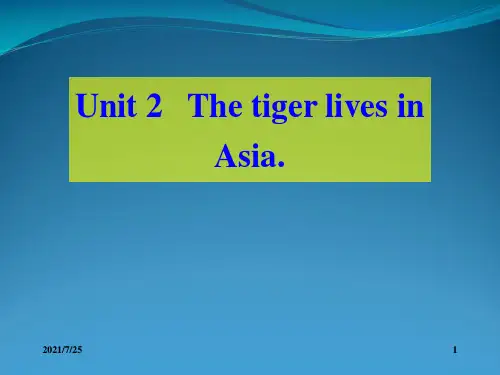
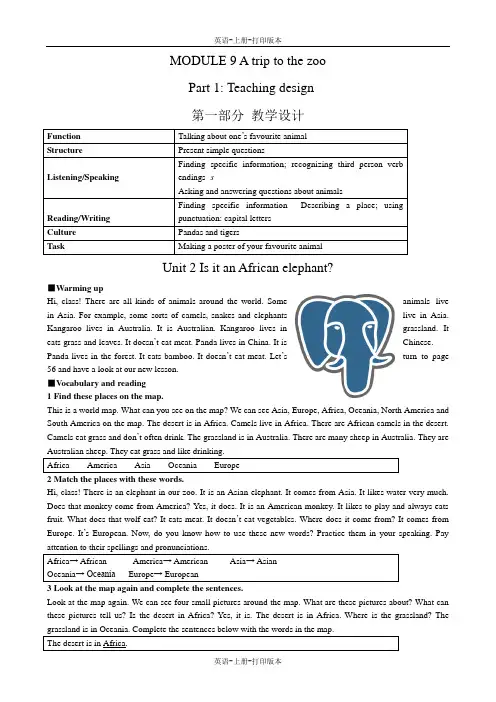
MODULE 9 A trip to the zooPart 1: Teaching design第一部分教学设计Function Talking about one’s favourite animal Structure Present simple questionsListening/Speaking Finding specific information; recognizing third person verb endings -sAsking and answering questions about animalsReading/Writing Finding specific information Describing a place; using punctuation: capital lettersCulture Pandas and tigersTask Making a poster of your favourite animalUnit 2 Is it an African elephant?■Warming upHi, class! There are all kinds of animals around the world. Some animals live in Asia. For example, some sorts of camels, snakes and elephants live in Asia. Kangaroo lives in Australia. It is Australian. Kangaroo lives in grassland. It eats grass and leaves. It doesn’t eat meat. Panda lives in China. It is Chinese. Panda lives in the forest. It eats bamboo. It doesn’t eat meat. Let’s turn to page 56 and have a look at our new lesson.■Vocabulary and reading1 Find these places on the map.This is a world map. What can you see on the map? We can see Asia, Europe, Africa, Oceania, North America and South America on the map. The desert is in Africa. Camels live in Africa. There are African camels in the desert. Camels eat grass and don’t often drink. The grassland is in Australia. There are many sheep in Australia. They areAfrica America Asia Oceania Europe2 Match the places with these words.Hi, class! There is an elephant in our zoo. It is an Asian elephant. It comes from Asia. It likes water very much. Does that monkey come from America? Yes, it does. It is an American monkey. It likes to play and always eats fruit. What does that wolf eat? It eats meat. It doesn’t eat vegetables. Where does it come from? It comes from Europe. It’s European. Now, do you know how to use these new words? Practice them in your speaking. PayAfrica→ African America→ American Asia→ AsianOceania→ Oceania Europe→ European3 Look at the map again and complete the sentences.Look at the map again. We can see four small pictures around the map. What are these pictures about? What can these pictures tell us? Is the desert in Africa? Yes, it is. The desert is in Africa. Where is the grassland? TheThe desert is in Africa.4 Read the text and choose the correct answers.Now we are going to read the text.This is a text about animals around the world. There are six kinds of animals here. Each of them is different from the others. Some of them like water. While some live in the desert and don’t often drink water. Some of them come from the grassland. While some come from the jungle. Read the text and try to get the meaning of it.While reading try to cut(断句)/ the sentences into parts, blacken(涂黑)the predicates, shade(加影)the connectives and underline(划线)the expressions.Now we read the text once again. This time pay attention to the details of the text. Choose the correct answers for the following questions. Pay attention to the sentence structure. After you choose the correct answers, please read■Writing5 Write the places with capital letters.Now we are going to study a new rule of writing. Words of places are written with capital letters. For example, we visit Beijing Zoo. The monkey comes from South America. The elephant is African. Pleas write the places with。
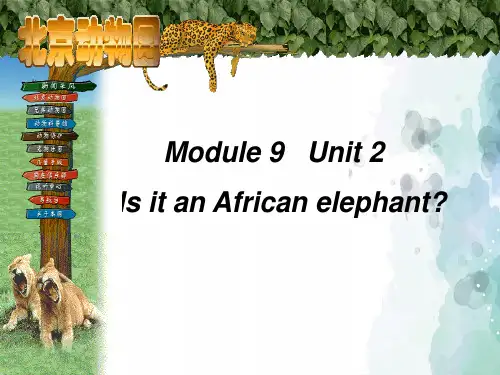
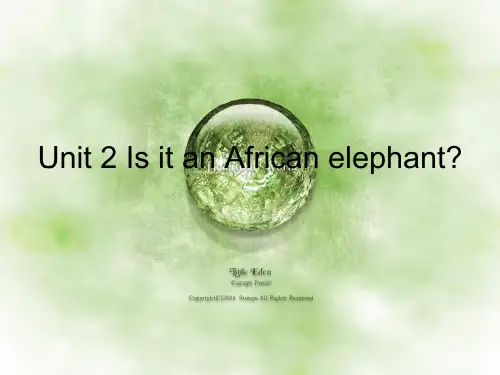
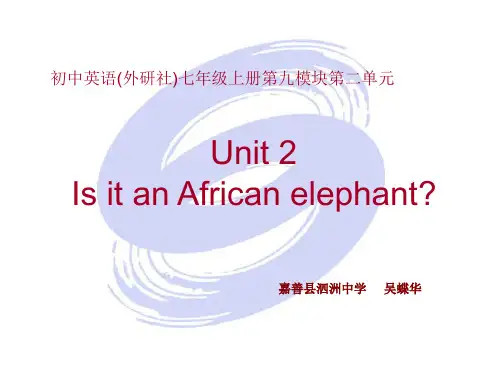
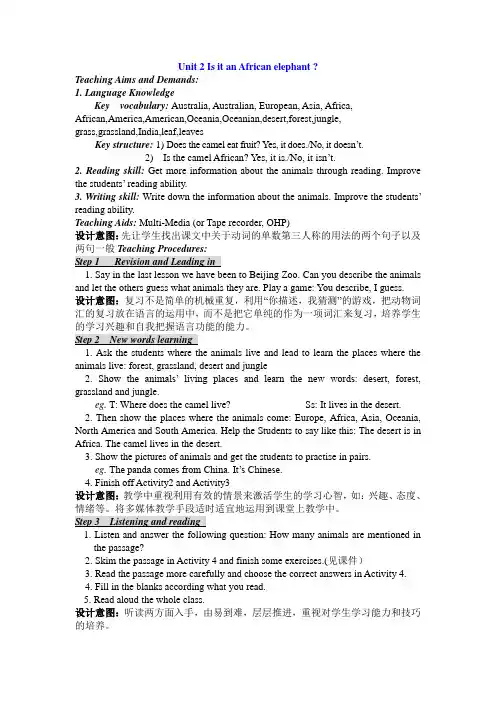
Unit 2 Is it an African elephant ?Teaching Aims and Demands:1. Language KnowledgeKey vocabulary: Australia, Australian, European, Asia, Africa,African,America,American,Oceania,Oceanian,desert,forest,jungle,grass,grassland,India,leaf,leavesKey structure: 1) Does the camel eat fruit? Y es, it does./No, it doesn’t.2) Is the camel African? Yes, it is./No, it isn’t.2. Reading skill: Get more information about the animals through reading. Improve the students’ reading ability.3. Writing skill: Write down the information about the animals.Improve the students’reading ability.Teaching Aids: Multi-Media (or Tape recorder, OHP)设计意图:先让学生找出课文中关于动词的单数第三人称的用法的两个句子以及两句一般Teaching Procedures:1. Say in the last lesson we have been to Beijing Zoo. Can you describe the animals and let the others guess what animals they are. Play a game: You describe, I guess.设计意图:复习不是简单的机械重复,利用“你描述,我猜测”的游戏,把动物词汇的复习放在语言的运用中,而不是把它单纯的作为一项词汇来复习,培养学生的学习兴趣和自我把握语言功能的能力。
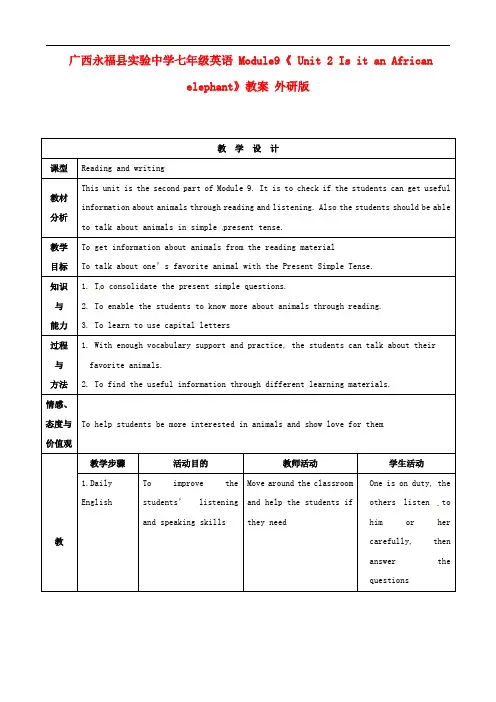
广西永福县实验中学七年级英语 Module9《 Unit 2 Is it an Africanelephant》教案外研版教学设计课型Reading and writing教材分析This unit is the second part of Module 9. It is to check if the students can get useful information about animals through reading and listening. Also the students should be able to talk about animals in simple present tense.教学目标To get information about animals from the reading materialTo talk about one’s favorite animal with the Present Simple Tense.知识与能力1. T o consolidate the present simple questions.2. To enable the students to know more about animals through reading.3. To learn to use capital letters过程与方法1. With enough vocabulary support and practice, the students can talk about their favorite animals.2. To find the useful information through different learning materials.情感、态度与价值观To help students be more interested in animals and show love for them教教学步骤活动目的教师活动学生活动1.DailyEnglishTo improve thestudents’ listeningand speaking skillsMove around the classroomand help the students ifthey needOne is on duty, theothers listen tohim or hercarefully, thenanswer thequestions学过程2. Revision To practise thevocabulary aboutanimals in the firstunitPlay the PPT quickly andhelp the students toremindLook at the pictureson PPT quickly andthen say out whatanimals they see3.PresentationTo make the studentslearn about the worldplaces on the mapShow the students a mapof the world and teachthe seven continentsObserve the mapcarefully and learnt he words about theseven continents4.Practice To learn about theanimals and the placesthey liveLead the students to learnabout the animals and theplaces they liveLook at the picturesand talk ab out them5.PresentationTo know abo ut thehabitat (forest,jungle, grassland,desert)1)Ask the students tolearn the habitat2)Ask the studentsquestions ab out wherethe animals liveLearn the habitat andanswer the que stionsabout it6.Reading To find specificinformationthrough reading. Tofocus on the details ofthe reading materialLead the students to readthe passage and choose thecorrect answers.Students read thepassage and choosethe correct answers.7.Games To improve theirinterest and collectmore information aboutanimals from thestudents1)Ask the students toguess the riddlesabout the animals2)Ask the studentsto describe an animal andthe others guess what itisPlay the gamestogether8.Free talk To arouse students toprotect the animals Show the topic to thestudents: Which place doyou think the animalswould like to go, the zooor the nature?What should we do for theanimals?Talk about the topicfreely.9.Summariza tion and exerciseTo consolidate thetarget languageHelp the students to sumup the target languagefirst ,then do exerciseFinish off a smallpiece of paper作业布置1.Writing: My favourite animal( A )2.Choose one kind of anim al on P57 Activity 4 and copy it(B)3.Speaking: talk about your favourite animal with your partner.(AB)教学反思I think the students like all kinds of animals because t hey are very excited when t hey are talking about the animals. And also they can’t wait to tell others what animal is his\her favourate. So funny a lesson.。
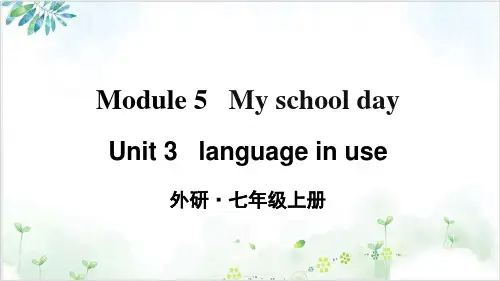
外研版七年级上册Module9 Unit 2Is it an African elephant?教学案例一、教材分析本课以“Is it an African elephant”为话题,学习相关动物的产地和习性,重点是地点名词的英文表达和相关句型。
主要分为两部分,第一部分是熟悉世界地图和掌握各大洲的英语名称和森林草原丛林沙漠在世界的分布,同时学习一构词法,怎么把名词转换为形容词。
第二部分是通过阅读练习,了解几种常见动物的生活习性,巩固学习第三人称单数的一般现在时的一般疑问句的用法以及写作中大小写的正确使用。
内容贴近学生的生活,容易提高学习的兴趣。
二、学情分析经过小学阶段和初中一段时间的学习,学生已经熟悉了部分动物英文名称和描述动物的句子。
本课则是进一步学习讲述动物的习性和居住地,让学生描述自己喜欢的动物。
由于动物的话题符合中学生的性格特点,因此,很大程度上能有效的激发学生的学习兴趣和积极性。
教师在教学中利用谚语、课件、图片、地图等来引导学生,采用带着问题阅读及小组合作的方式,挖掘学生内在的潜能,培养学生综合学习的能力。
三、教学目标(一)知识目标1.掌握重点词汇:Australia,Australian,European,Asia, Africa,African,America,American,Oceania,Oceanian,desert,forest,jungle,grass,grassland,India,leaf,leaves。
2.掌握的重点句子:Does the camel eat fruit?Yes, it does./No, it doesn’t. Is the camel African? Yes it is ./No ,it isn’t. The desert is in Africa….3.掌握写作中地点名词需大写的相关知识。
(二)技能目标1.能读懂有关描述动物的短文,并提取有效信息。